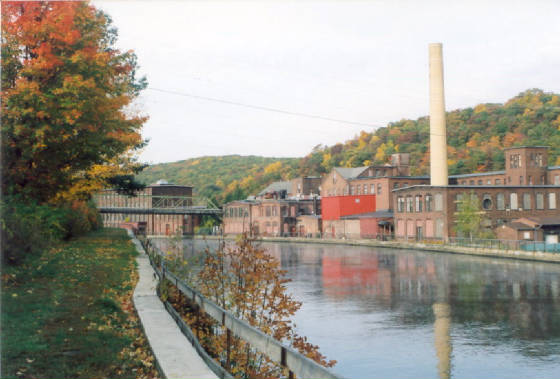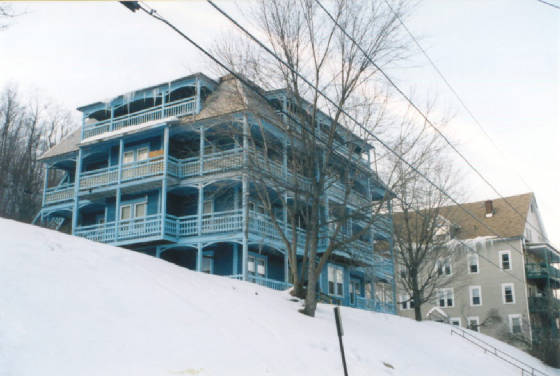|
|
For several years, I have been making occasional visits to Turners Falls, Massachusetts. It’s a small, urban-like village on the Connecticut River, just east of Greenfield. Though it seems to be turning the corner now, it is still suffering from many of the problems familiar to North Adams residents: factory closings, demolition of historic landmarks, blighted neighborhoods, and a hauntingly empty downtown.
On the hill overlooking Avenue A, the village’s main street, are the Victorian houses of its gentry. Behind those houses, streets are full of well-kept, post-World War II homes with snappy green lawns. But on Avenue A and its surrounding neighborhood, life is a series of day-to-day battles for most of its elderly and fixed-income residents, battles not unlike those fought by many generations of mill workers who once occupied the same spaces.
It soon became obvious to me that there is a social and cultural distinction between the “Hill” and the “Avenue.” One older resident who was raised on the Avenue complained to me that when she was a child, she couldn’t get into the brand new elementary school because, “I wasn’t one of the Hill kids.”
But the difference may be more a perception than a reality, at least according to one young woman I met who grew up in Turners in the 1970s and 1980s. She lived in one of the nicer post-war houses behind the hill, but had relatives on the Avenue. She recalled that some of her classmates would tease her about being rich, because of where she lived.
“Even though we had a house on the hill, it was not like we were rolling in the dough,” she told me passionately. “They had no idea, no idea at all. Everything my parents have is because they worked hard for it and put it away. I didn’t have the nicest clothes. Don’t get me wrong; it wasn’t like I had rips in my jeans. I had enough, but we struggled just like everyone else.”
I asked her if there is a problem with racism in her hometown. “There’s racism, but it’s not about black and white; it’s about uptown and downtown.”
For many folks in North Berkshire, uptown and downtown could easily translate to Williamstown and North Adams. Much of North Adams is dotted with old mills, multi-family houses and tenements. Much of Williamstown’s center is a college campus full of stately buildings surrounded by a neighborhood of radiant Victorian houses.
But Williamstown and North Adams have much in common. The abandoned Photech mill on Cole Avenue is one surviving example. First called the Williamstown Manufacturing Company in 1866, it recruited French-Canadians, who moved into company-owned tenements. In 1910, it was purchased by Berkshire Fine Spinning Associates, and was sold in 1940 to the Gevaert Company. And now it’s a hazardous materials site facing a problematic demolition.
Both towns are wrestling with design improvements and retail development downtown: Spring and Water Streets in Williamstown, Main and Center Streets in North Adams. Williamstown continues to be swallowed up by the expansion of Williams College. In the 1970s, homes and businesses on Church, Montana, and Ashland Streets in North Adams were demolished in favor of the expansion of North Adams State College. Now called Massachusetts College of Liberal Arts, it continues to chew up the surrounding neighborhood.
Both communities share art and technology as a tourist attraction and an economic engine. And when folks in Williamstown go out to dinner and a show, they often head for North Adams.
With that in mind, I took pleasure in being asked to give walking tours of North Adams to four sixth-grade classes at Williamstown Elementary School. The field trips were prompted by a scheduled visit to the school by author Elizabeth Winthrop, a summer resident of Williamstown, who recently wrote Dear Mr. President: Letters from a Mill Town Girl.
Through fictional letters to and from President Franklin Roosevelt, the book tells the story of a girl Winthrop calls Emma Bartoletti, an Italian-American girl who grows up in the Little Italy section of North Adams in the 1930s. From the letters, readers learn how the Great Depression affected Emma and her family. The characters are based on real people that the author interviewed in the area; and the events mentioned in Emma’s letters are based on real events that took place in North Adams. It’s a clever and fascinating book, one that should engage both children and adults.
On the walking tours, I showed the students where the fictional Emma lived (the blue tenement at 132-144 Furnace Street, often called the Cancro Block), and I pointed out what North Adams looked like in the 1930s, and how it has changed. For these wonderfully curious young people, it turned out to be a day of discoveries. Other discoveries await North Adams students whose teachers wish to take them on a walking tour of Williamstown.
The following are some of the comments from the sixth-graders:
“I hadn’t known that the library belonged to Mr. Blackinton.”
“The view behind the post office showed just the tops of the buildings. It was great!”
“I like the view of the church steeples and the different shapes of the roofs and the way the sun hits them.”
“I liked the old signs on the buildings.”
“It was something how everything had changed since 1937.”
“Fifty-five Main Street is the site of a former movie theatre.”
“The Richmond Hotel was on the site of the Holiday Inn.”
“I didn’t know that so many buildings in North Adams were taken down.”
“There used to be many more buildings and movie theaters.”
“Bank Street was lined with buildings.”
“I’m glad they kept some of the old buildings with the arches and architecture.”
“It was neat how the class liked the older buildings better.”
“Mass MoCA was Sprague Electric.”
“You needed a badge to get into the mill.”
“There were over 4,000 people working in the mill.”
“People used to live in clusters near their place of work, because they had to walk to work.”
“Thirty trains would go by each day.”
“Over 190 men died working in the Hoosac Tunnel.”
“The Hoosac Tunnel is five miles long.”
“I thought it was interesting that the school kids went home for lunch every day.”
“Emma’s house was unique and stood out in North Adams.”
“Emma’s house was so big, that other members of her family could live with them.”
“It was interesting how many families lived in one house.”
“I thought it was neat to have staircases on the outside of Emma’s house.”
“Emma’s home was someone’s idea of a European castle.”
|
|

